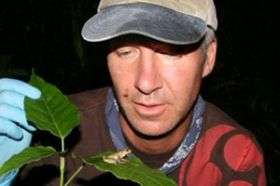Rare frog find gives herpetologist hope

(PhysOrg.com) -- A rare female frog has been seen for the first time in 20 years during an expedition to Central America by scientists from The University of Manchester and Chester Zoo.
The tiny tree frog Isthmohyla rivularis was seen in Costa Rica's Monteverde Cloud Forest Preserve.
This species was thought to have become extinct two decades ago, but last year Andrew Gray from The University's Manchester Museum found and photographed a male.
But the discovery of the pregnant female and also more males suggests this species is breeding and has been able to survive – while many other species have been killed by a deadly fungal skin disease.
Speaking to BBC Online, which is accompanying the party in Costa Rica, Andrew Gray from Manchester Museum at the University of Manchester, said: "This has been the highlight of the whole of my career.
"Now that we know that both sexes exist in the wild, we should intensify efforts to understand their ecology and further their conservation."
The team trekked deep into the forest to a spot close to where the male Isthmohyla rivularis was spotted last year. They had few clues about where the frogs might be and the search could only take place at night.
After discovering another male from its soft insect-like call, Luis Obando, head of park maintenance at Monteverde's Tropical Science Centre, found the tiny female, which was sitting on a leaf.
Mr Gray told the BBC: "It is hard to describe just how unlikely it was to have discovered a female of this particular species.
"The only time you ever come across a female is by chance - and it is only once in a blue moon that they come down to lay their eggs. You really have to be in the right place at the right time.
"You could come out here every night for a year and not see a thing. I really think that this time we have had luck on our side."
The 2.5cm-long female was released after the discovery – but only after a swab was taken from its skin to test whether it is carrying the deadly chytrid fungus.
In recent days, physicist Dr Mark Dickinson from The Photon Science Institute at The University has been able to use a small, portable pen-like device called a spectrometer to examine the skin of several tree frogs.
This non-invasive technique allows them to see how much light the frog is reflecting and understand more about the properties of their skin.
The researchers believe that the ability to sit out in the sun may allow the frogs' skin to heat up just enough to kill off the fungus - preventing the disease from taking its grip.
However, there are concerns that increased cloud cover in their natural habitat as a result of global warming may limit their opportunities for sunbathing.
A team from The University of Manchester and Chester Zoo has been working out in Costa Rica over the last two weeks.
Provided by University of Manchester















